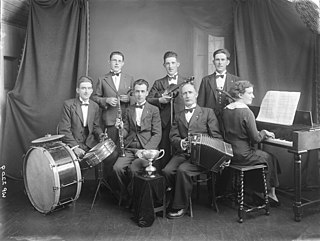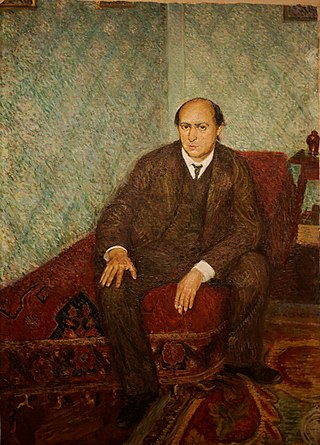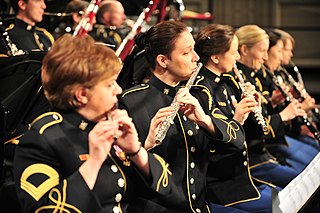Related Research Articles

The bass clarinet is a musical instrument of the clarinet family. Like the more common soprano B♭ clarinet, it is usually pitched in B♭, but it plays notes an octave below the soprano B♭ clarinet. Bass clarinets in other keys, notably C and A, also exist, but are very rare. Bass clarinets regularly perform in orchestras, wind ensembles and concert bands, and occasionally in marching bands, and play an occasional solo role in contemporary music and jazz in particular.

A septet is a formation containing exactly seven members. It is commonly associated with musical groups but can be applied to any situation where seven similar or related objects are considered a single unit, such as a seven-line stanza of poetry.
John Harris Harbison is an American composer and academic.
The two Serenades, Op. 11 and 16, represent early efforts by Johannes Brahms to write orchestral music. They both date from after the 1856 death of Robert Schumann when Brahms was residing in Detmold and had access to an orchestra.
The Young Person's Guide to the Orchestra, Op. 34, is a 1945 musical composition by Benjamin Britten with a subtitle Variations and Fugue on a Theme of Purcell. It was based on the second movement, "Rondeau", of the Abdelazer suite. It was originally commissioned for the British educational documentary film called Instruments of the Orchestra released on 29 November 1946, directed by Muir Mathieson and featuring the London Symphony Orchestra conducted by Malcolm Sargent; Sargent also conducted the concert première on 15 October 1946 with the Liverpool Philharmonic in the Philharmonic Hall, Liverpool, England.

The E-flat clarinet is a member of the clarinet family, smaller than the more common B♭ clarinet and pitched a perfect fourth higher. It is typically considered the sopranino or piccolo member of the clarinet family and is a transposing instrument in E♭ with a sounding pitch a minor third higher than written. The E-flat clarinet has a total length of about 49 centimetres (19 in).
Lollapalooza is a short piece composed by American minimalist composer John Adams in 1995. The piece is based on the rhythm of the word 'Lollapalooza'. It was composed as a fortieth birthday present to the British conductor Simon Rattle, with whom Adams has worked in the past.

In music, an octet is a musical ensemble consisting of eight instruments or voices, or a musical composition written for such an ensemble.

The Bard, Op. 64, tone poem for orchestra written in 1913 by the Finnish composer Jean Sibelius. It was first performed in Helsinki on 27 March 1913 by the Philharmonic Society Orchestra, conducted by the composer himself, but he revised it in 1914. The new version was first performed in Helsinki on 9 January 1916, again under the baton of the composer.

Yuri Sergeyevich Kasparov is a Russian composer, music teacher and a professor at the Moscow Conservatory where he had studied for his doctorate under Edison Denisov. Under the patronage of Denisov, he founded the Moscow Contemporary Music Ensemble in 1990 and is its artistic director. He is the chairman of the Russian section of the International Society for Contemporary Music.

Requiem is an instrumental musical composition by Hans Werner Henze, premiered in Cologne on 24 February 1993. It consists of nine sacred concertos for piano solo, trumpet and large chamber orchestra. About this piece, the composer has the following comments.
These nine instrumental pieces are concerned with the human fears and problems of our time, with illness and death, love and loneliness, and in particular with the character of Michael Vyner, an extremely lively and passionate man, his life and his death, and my grief at his loss which stands for the loss of so many others who have also tragically departed from our world. The spirit of this music can be explained by such facts and by our time, by which it seems to me to be strongly influenced, by its horrors and passions, its beauty and dynamics. The movements of the Requiem can be played separately or in any desired combination. Hans Werner Henze
Chamber Symphony No. 2, Op. 38, by Arnold Schoenberg was begun in 1906 and completed in 1939. The work is scored for 2 flutes, 2 oboes, 2 clarinets, 2 bassoons, 2 horns, 2 trumpets and strings, and is divided into two movements, the first marked Adagio and the second marked Con Fuoco-Lento. The work's belated completion was prompted by the conductor Fritz Stiedry, who asked Schoenberg for an orchestral piece for his New Friends of Music Orchestra in New York. The work was first performed there on December 14, 1940, under Stiedry's direction.
Zdeněk Lukáš was a Czech composer. He authored over 330 works.

The trumpet repertoire consists of solo literature and orchestral or, more commonly, band parts written for the trumpet. Tracings its origins to 1500 BC, the trumpet is a musical instrument with the highest register in the brass family.
Naive and Sentimental Music is a symphonic work by American composer John Adams. The title of the work alludes to an essay by Friedrich Schiller, On Naïve and Sentimental Poetry, that contrasts a creative personality that creates art for its own sake versus one conscious of other purposes, such as art’s place in history. The composer cites both the slowly developing harmonies of Bruckner's Fourth Symphony and the atmosphere of the Sonoma coastline as inspirations for the work. The piece was co-commissioned by the Los Angeles Philharmonic, the Ensemble Modern, the Vancouver Symphony Orchestra, and the Sydney Symphony Orchestra. It received its first public performance by the Los Angeles Philharmonic conducted by Esa-Pekka Salonen on February 19, 1999. A recording by Salonen and the Los Angeles Philharmonic was subsequently released by Nonesuch Records.

The Chamber Symphony No. 1 in E major, Op. 9 is a composition by Austrian composer Arnold Schoenberg.

The woodwind section, which consists of woodwind instruments, is one of the main sections of an orchestra or concert band. Woodwind sections contain instruments given Hornbostel-Sachs classifications of 421 and 422, but exclude 423
Jonatan Sersam is a Swedish composer and pianist. His music has been performed by Malmö Symfoniorkester, Helsingborgs Symfoniorkester, ensemble ICTUS, Schallfeld Ensemble, Ensemble Zeitfluss, Ensemble FontanaMix, Norrköpings Symfoniorkester, Swedish Wind Ensemble, Marco Fusi, Ruído Vermelho, Musica Vitae and the Kreutzer Quartet among others. Sersam was awarded Saltöstftelsens Tonsättarstipendium 2023 for his piece Presencia de Sombra for bass viol, cello and soprano
Finding Rothko is a composition for chamber orchestra by the American composer Adam Schoenberg. The work was commissioned by the Germantown, Tennessee-based IRIS Orchestra under the conductor Michael Stern. It was first performed by the IRIS Orchestra under Stern on January 13, 2007.
References
- 1 2 3 4 Adams, John. "John Adams - Chamber Symphony". Boosey & Hawkes. Retrieved 20 February 2015.
- ↑ "Adams: Chamber Symphony; Grand Pianola Music". www.amazon.com. Retrieved 20 February 2015.
- ↑ Adams, John (June 1994). "John Adams on the Chamber Symphony". Earbox. Archived from the original on 1 June 2015. Retrieved 1 June 2015.
- ↑ Huizenga, Tom (31 January 2015). "Bach, Brits And A Bodacious Boston Orchestra: New Classical Albums". NPR. Retrieved 20 February 2015.
- ↑ Kirzinger, Robert. "Virtuosity's Velocity | Program Notes" (PDF). Retrieved 20 February 2015.